A student was–performing an activity to prove the requirements for photosynthesis. During this activity, he kept two identical healthy potted plantsA and Bin dark for 72 hours. After 72 hours, he covered plant A and B by bell shaped jars separately. While covering the plants with separate bell jars, he kept KOH in the watch glass by the side of the plant in setup A and not in setup B. Both these setups were made air tight and were kept in light for 6 hours. Then, Iodine Test was performed with one leaf from each of the two plants A and B.
Which of the following steps can be followed for making the apparatus air tight?
i. placing the plants on glass plate
ii. using a suction pump.
iii. applying Vaseline to seal the bottom of jar.
iv. creating vacuum
i and ii
ii. and iii
i. and iii
ii. And iv
To determine which steps can be followed to make the apparatus airtight for the experiment on photosynthesis, we can analyze the options provided:
1. Placing the plants on a glass plate: This is a valid step as it provides a stable base for the bell jars and helps in ensuring that the jars can be sealed properly at the bottom.
2. Using a suction pump: While a suction pump can create a vacuum, it is not necessary for making the apparatus airtight in this context. The primary goal is to prevent air exchange, which can be achieved through simpler methods.
3. Applying Vaseline to seal the bottom of the jar: This is an effective method to ensure that there are no gaps between the jar and the glass plate, thus making the setup airtight.
4. Creating a vacuum: Similar to using a suction pump, creating a vacuum is not required for this experiment. The goal is to simply prevent air from entering or leaving the setup.
Based on this analysis, the steps that can be followed to make the apparatus airtight are:
- i. Placing the plants on a glass plate
- iii. Applying Vaseline to seal the bottom of the jar
Thus, the correct answer is option 3, which includes steps i and iii.
- iii. Applying Vaseline to seal the bottom of the jar
Topper's Solved these Questions
- SAMPLE PAPER 2022BOOK - CBSE MODEL PAPERCHAPTER - SAMPLE PAPER 2022EXERCISE - SECTION - A
7 Videos
- SAMPLE PAPER 2022BOOK - CBSE MODEL PAPERCHAPTER - SAMPLE PAPER 2022EXERCISE - SECTION - B
7 Videos
- Additional Practice QuestionsBOOK - CBSE MODEL PAPERCHAPTER - Additional Practice QuestionsEXERCISE - Question
18 Videos
- SAMPLE PAPER 2022 TERM IIBOOK - CBSE MODEL PAPERCHAPTER - SAMPLE PAPER 2022 TERM IIEXERCISE - SECTION C
2 Videos
Similar Questions
A student was–performing an activity to prove the requirements for photosynthesis. During this activity, he kept two identical healthy potted plantsA and Bin dark for 72 hours. After 72 hours, he covered plant A and B by bell shaped jars separately. While covering the plants with separate bell jars, he kept KOH in the watch glass by the side of the plant in setup A and not in setup B. Both these setups were made air tight and were kept in light for 6 hours. Then, Iodine Test was performed with one leaf from each of the two plants A and B.
The function of KOH is to absorb
View SolutionA student was–performing an activity to prove the requirements for photosynthesis. During this activity, he kept two identical healthy potted plantsA and Bin dark for 72 hours. After 72 hours, he covered plant A and B by bell shaped jars separately. While covering the plants with separate bell jars, he kept KOH in the watch glass by the side of the plant in setup A and not in setup B. Both these setups were made air tight and were kept in light for 6 hours. Then, Iodine Test was performed with one leaf from each of the two plants A and B.
Which of the following statements shows the correct results of Iodine Test performed on the leaf from plant A and B respectively?
View Solution
Knowledge Check
Case : The Figure shown below represents an activity to prove the requirements for photosynthesis. During this activity, two healthy potted plants were kept in the dark for 72 hours. After 72 hours, KOH is kept in the watch glass in setup X and 'not in setup Y. Both these setups are air tight and have been kept in light for 6 hours. Then, lodine Test is performed with one leaf from each of the two plants X and Y.

Which of the following steps can be followed for making the apparatus air tight?
(I) placing the plants on glass plate
(II) using a suction pump.
(III) applying aseline to seal the bottom of jar.
(IV) creating vacuumA(I) and (III)B(II) and (III)C(I) and (IV)D(II) and (IV)Case : The Figure shown below represents an activity to prove the requirements for photosynthesis. During this activity, two healthy potted plants were kept in the dark for 72 hours. After 72 hours, KOH is kept in the watch glass in setup X and 'not in setup Y. Both these setups are air tight and have been kept in light for 6 hours. Then, lodine Test is performed with one leaf from each of the two plants X and Y.
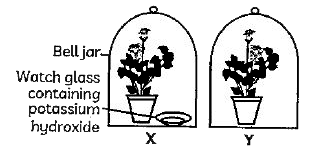
This experimental set up is used to prove essentiality of which of the following requirements of photosynthesis?AChlorophyllBOxygenCCarbon dioxideDSunlightCase : The Figure shown below represents an activity to prove the requirements for photosynthesis. During this activity, two healthy potted plants were kept in the dark for 72 hours. After 72 hours, KOH is kept in the watch glass in setup X and 'not in setup Y. Both these setups are air tight and have been kept in light for 6 hours. Then, lodine Test is performed with one leaf from each of the two plants X and Y.
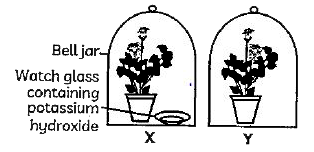
Which of the following statements shows the correct results of lodine Test performed on the leaf from plant X and Y respectively?ABlue - black colour would be obtained on the leaf of plant X and no change in colour on leaf of plant Y.BBlue - black colour would be obtained on the leaf of plant Y and no change in colour on leaf of plant X.CRed colour would be obtained on the leaf of plant X and brown colour on the leaf of plant Y.DRed colour would be obtained on the leaf of plant Y and brown colour on the leaf of plant X.
A student was–performing an activity to prove the requirements for photosynthesis. During this activity, he kept two identical healthy potted plantsA and Bin dark for 72 hours. After 72 hours, he covered plant A and B by bell shaped jars separately. While covering the plants with separate bell jars, he kept KOH in the watch glass by the side of the plant in setup A and not in setup B. Both these setups were made air tight and were kept in light for 6 hours. Then, Iodine Test was performed with one leaf from each of the two plants A and B.
This experimental set up is used to prove essentiality of which of the following requirements of photosynthesis?
View SolutionThe Figure shown below represents an activity to prove the requirements for photosynthesis. During this activity, two healthy potted plants were kept in the dark for 72 hours. After 72 hours, KOH is kept in the watch glass in setup X and not in setup Y. Both these setups are air tight and have been kept in light for 6 hours. Then, Iodine Test is performed with one leaf from each of the two plants X and Y.

Which of the following steps can be followed for making the apparatus air tight?
i. placing the plants on glass plate
ii. using a suction pump.
iii. applying aseline to seal the bottom of jar.
iv. creating vacuum
View SolutionThe Figure shown below represents an activity to prove the requirements for photosynthesis. During this activity, two healthy potted plants were kept in the dark for 72 hours. After 72 hours, KOH is kept in the watch glass in setup X and not in setup Y. Both these setups are air tight and have been kept in light for 6 hours. Then, Iodine Test is performed with one leaf from each of the two plants X and Y.
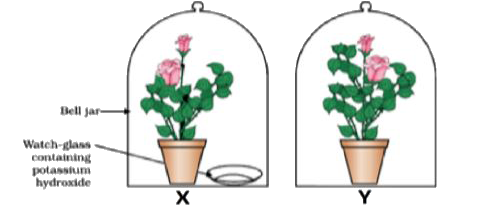
This experimental set up is used to prove essentiality of which of the following requirements of photosynthesis?
View SolutionThe Figure shown below represents an activity to prove the requirements for photosynthesis. During this activity, two healthy potted plants were kept in the dark for 72 hours. After 72 hours, KOH is kept in the watch glass in setup X and not in setup Y. Both these setups are air tight and have been kept in light for 6 hours. Then, Iodine Test is performed with one leaf from each of the two plants X and Y.
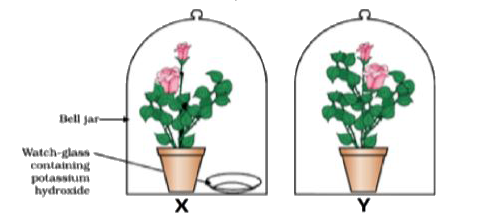
Which of the following statements shows the correct results of Iodine Test performed on the leaf from plant X and Y respectively?
View SolutionThe Figure shown below represents an activity to prove the requirements for photosynthesis. During this activity, two healthy potted plants were kept in the dark for 72 hours. After 72 hours, KOH is kept in the watch glass in setup X and not in setup Y. Both these setups are air tight and have been kept in light for 6 hours. Then, Iodine Test is performed with one leaf from each of the two plants X and Y.
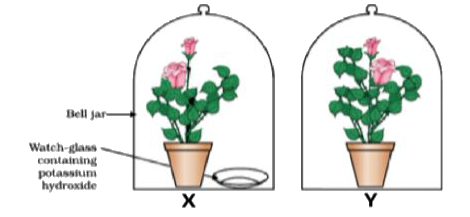
The function of KOH is to absorb
View Solution
